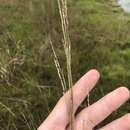Comprehensive Description
provided by North American Flora
Panicum tenerum Beyr.; Trin. Mem. Acad. St.-Petersb. VI. 3 2 :
341. 1834.
Panicum anceps sirictum Chapm. Fl. S. U. S. 573. 1860.
Plants in small tufts from a knotted crown, 40-90 cm. high, olivaceous; culms erect, stiff and wiry, producing small, solitary panicles from the upper nodes or remaining simple, glabrous ; leaf-sheaths much shorter than the internodes, the upper glabrous, the lower sparsely to copiously papillose-pubescent toward the summit with soft, spreading or reflexed hairs; blades 4-15 cm. long, 2-4 mm. wide (the uppermost much reduced), erect, firm, drying involute at least toward the summit, pilose on the upper surface toward the base, or the lower sometimes on both surfaces; terminal panicles rather short-exserted, 3-8 cm. long, rarely more than 5 mm. wide, the short, appressed, subracemose branches bearing rather crowded spikelets throughout their length, the pedicels usually with a few long hairs at the summit; spikelets 2.2-2.8 mm. long, 0.8-1 mm. wide, narrowly ovate, pointed; first glume clasping, half as long as the spikelet or more, 1 -nerved, glabrous or obscurely strigose toward the summit; second glume and sterile lemma equal, exceeding the fruit, 5-7-nerved, glabrous; fruit 1.7-1.8 mm. long, about 0.8 mm. wide.
Type locality: Georgia.
Distribution: Georgia to Texas; Bahamas, Cuba, and Porto Rico.
- bibliographic citation
- George Valentine Nash. 1915. (POALES); POACEAE (pars). North American flora. vol 17(3). New York Botanical Garden, New York, NY
Physical Description
provided by USDA PLANTS text
Perennials, Terrestrial, not aquatic, Rhizomes present, Rhizome short and compact, stems close, Stems nodes swollen or brittle, Stems erect or ascending, Stems caespitose, tufted, or clustered, S tems terete, round in cross section, or polygonal, Stems branching above base or distally at nodes, Stem internodes hollow, Stems with inflorescence less than 1 m tall, Stems, culms, or scapes exceeding basal leaves, Leaves mostly basal, below middle of stem, Leaves mostly cauline, Leaves conspicuously 2-ranked, distichous, Leaves sheathing at base, Leaf sheath mostly open, or loose, Leaf sheath smooth, glabrous, Leaf sheath hairy, hispid or prickly, Leaf sheath hairy at summit, throat, or collar, Leaf sheath and blade differentiated, Leaf blades linear, Leaf blades very narrow or filiform, less than 2 mm wide, Leaf blades 2-10 mm wide, Leaf blades mostly flat, Leaf blade margins folded, involute, or conduplicate, Leaf blades mostly glabrous, Leaf blades scabrous, roughened, or wrinkled, Ligule present, Ligule a fringe of hairs, Inflorescence terminal, Inflorescence a contracted panicle, narrowly paniculate, branches appressed or ascending, Inflorescence solitary, with 1 s pike, fascicle, glomerule, head, or cluster per stem or culm, Inflorescence branches more than 10 to numerous, Inflorescence branches 1-sided, Flowers bisexual, Spikelets pedicellate, Spikelets sessile or subsessile, Spikelets dorsally compressed or terete, Spikelet less than 3 mm wide, Spikelets with 1 fertile floret, Spikelets with 2 florets, Spikelet with 1 fertile floret and 1-2 sterile florets, Spikelets solitary at rachis nodes, Spikelets all alike and fertille, Spikelets bisexual, Spikelets disarticulating below the glumes, Rachilla or pedicel glabrous, Glumes present, empty bracts, Glumes 2 clearly present, Glumes distinctly unequal, Glumes equal to or longer than adjacent lemma, Glume equal to or longer than spikelet, Glumes 3 nerved, Glumes 4-7 nerved, Lemma similar in texture to glumes, Lemma 5-7 nerved, Lemma glabrous, Lemma apex truncate, rounded, or obtuse, Lemma awnless, Lemma margins inrolled, tightly covering palea and caryopsis, Lemma straight, Palea presen t, well developed, Palea about equal to lemma, Stamens 3, Styles 2-fid, deeply 2-branched, Stigmas 2, Fruit - caryopsis, Caryopsis ellipsoid, longitudinally grooved, hilum long-linear.

